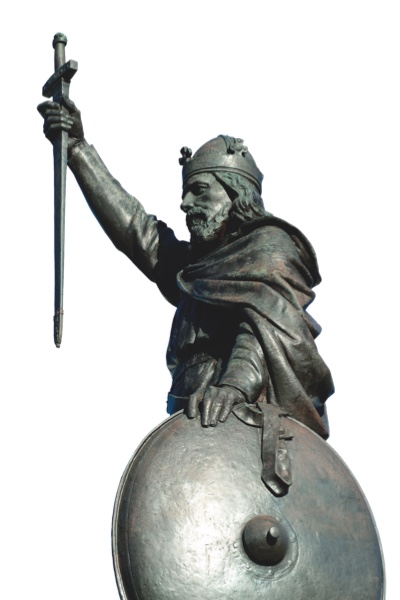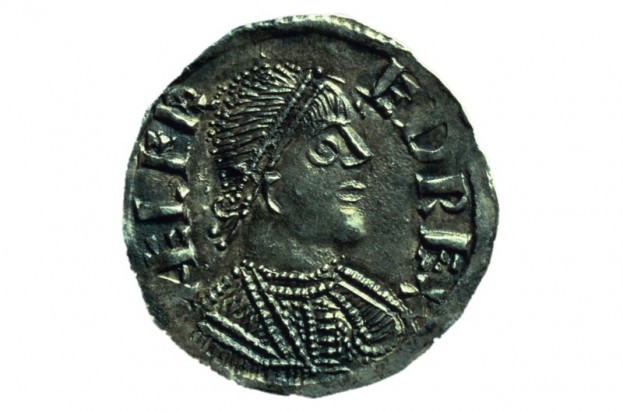|
Alfred the Great Part 4: The Measure of His SuccessAlfred recovered from this lowpoint in his life, suffering through a lonely winter in the marshes; when spring arrived, the king gathered men from the surrounding areas and struck back at the Danes. They won a smashing victory at Edington, in Wiltshire, thanks in large part to the successful implementation by Alfred's fyrd (or amy) of what would become the vaunted Saxon Shield Wall. Similar to the phalanx of Ancient Greece, employed so successfully by the armies of Alexander the Great, or the legion of Ancient Rome, the Shield Wall tasked Saxon warriors to stand side-by-side so their shields overlapped with the people next to them. The warriors left small gaps in between the shields into which they would thrust the spears that they held in their non-shield hands. The Shield Wall proved difficult to penetrate for many foes, and such was the case with the Danes at Edington. This was another victory for Alfred's forces against an enemy ensconced on high ground. Alfred and the fyrd pursued Guthrum and the Danes back to Chippenham; there, the Saxons settled down for a siege. Guthrum sued for peace after just a few weeks, and the result was the Treaty of Wedmore, in 878, after which the Danes retreated to East Anglia. One significant and possibly surreal set of events associated with this period of peace between the two peoples is that Guthrum became a Christian, converting from his Danish faith; that Alfred was Guthrum's sponsor at the baptism ceremony; and that the two kings then spent 12 days in ceremony and feasting while they finalized the terms of the treaty. Another lull in the fighting gave way to renewed fighting. The Danes invaded Kent in 885 and Alfred struck back, reclaiming London in the process. Another treaty followed, including a line of demarcation that came to known as the Danelaw. It was also at this time that the peoples of the other Anglo-Saxon kingdoms submitted to Alfred's rule. Under the terms of previous overlordships, Alfred could be termed bretwalda. Many historians, however, regard Alfred as the first true "king of the English."
He also kept his eye on his people's future needs. He had new schools established and encouraged young people to learn, in English as well as in Latin. A scholar himself, Alfred is said to have translated from Latin into English a few books on religion and philosophy. Manuscript production, basically on hold after the Danish sacking of monasteries, began again. Alfred established a court school for his own children to attend and recruited scholars from Europe to help promote learning all across England. Alfred also reorganized the legal system, building on the systems of previous kings like Æthelbert and Offa and adding his own laws. He had new coins minted; some of these coins referred to Alfred as "king of the English."
The cause of death of Alfred is still not known. It was not recorded at the time he died. He was known to have suffered several illnesses throughout his life. He was buried at Winchester, the capital of Wessex. Among the many statues of Alfred that exist today is a large one in the modern city of Winchester. It wasn't until the 16th Century that he began to be called Alfred the Great. He is a great hero to the English and the namesake of many schools, other buildings, and even a Royal Navy ship. |
|
Social Studies for Kids
copyright 2002–2025
David White

 Alfred learned his lesson from the "burning of the cakes" story by addressing his people's immediate needs. He directed the construction of a series of burhs, or fortified towns, to help defend against Danish counterattacks. He directed the building of ships, to counter Danish movements at sea. He reorganized the army on a rotating basis, so that farmers could be soldiers for a time and then go home to tend to their farms for a time as well, before rotating back into the army.
Alfred learned his lesson from the "burning of the cakes" story by addressing his people's immediate needs. He directed the construction of a series of burhs, or fortified towns, to help defend against Danish counterattacks. He directed the building of ships, to counter Danish movements at sea. He reorganized the army on a rotating basis, so that farmers could be soldiers for a time and then go home to tend to their farms for a time as well, before rotating back into the army. Alfred had in 868 married Ealhswith, the daughter of a Mercian nobleman. Together, Alfred and Ealhswith had several children, including
Alfred had in 868 married Ealhswith, the daughter of a Mercian nobleman. Together, Alfred and Ealhswith had several children, including 
